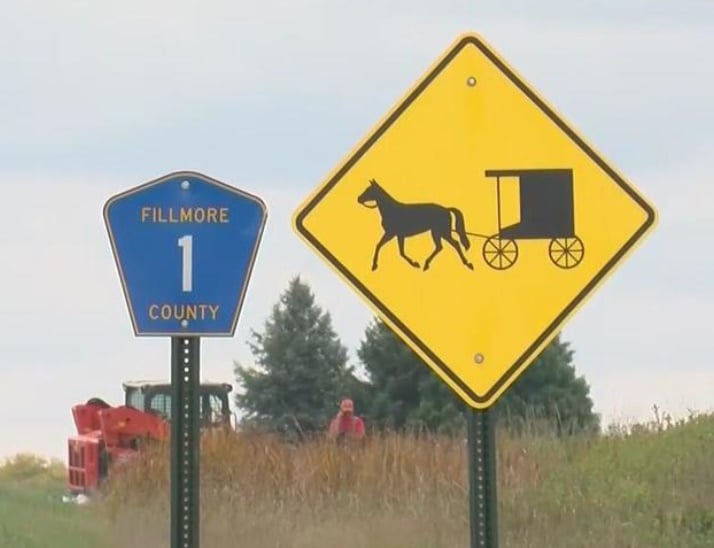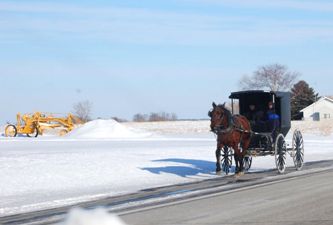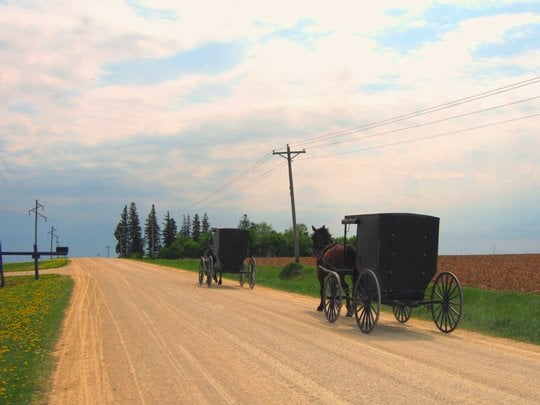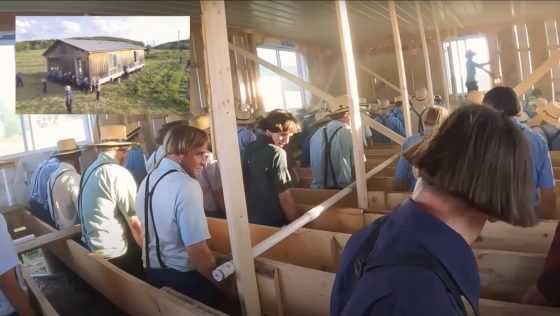The Amish in Minnesota: 2024 Guide (23 Communities)
Minnesota‘s 23 Amish settlements are clustered in two general regions: the southeast corner of the state, and the central-northwest. Amish first settled in the North Star State in the late 1800s, forming two short-lived communities. Like other Midwestern states, Minnesota has steadily attracted new Amish settlement over the past several decades. As of 2024, over 5,000 Amish live in Minnesota.

Minnesota Amish Communities:
- Harmony – The Harmony/Canton area of Fillmore County is home to Minnesota’s largest Amish settlement, with six church districts and over 700 people. Two more Amish communities are found in Fillmore County
- Todd County – Five separate Amish settlements are found in Todd County in central Minnesota
- Other MN Amish communities – Wadena, the oldest Minnesota Amish community, was founded in 1972. Other settlements can be found in Winona County, Mille Lacs County, Otter Tail County, and others. Amish live in nearly two dozen distinct locations in the state.
Harmony
The Harmony Amish community (are of Harmony and Canton) was founded by Swartzentruber Amish from Wayne County, Ohio, who began settling in this corner of Fillmore County in 1974. Like other Swartzentruber Amish, this conservative group uses only limited technology in their homes, businesses, and buggies.

The Amish of Harmony make a living by farming, working construction jobs, and like Swartzentruber counterparts in the Ethridge, Tennessee Amish settlement, various communities Ohio, and numerous other states, by operating low-tech businesses. Basket, furniture, and quilt-making are popular here. Jams, rugs, quilts, baked goods, and cashew crunch are among the items available for sale at local Amish homes.
The Harmony Amish community is the largest in Minnesota, at six church districts, and currently the third-oldest settlement in the state. However, this settlement has seen a decline in size over the past decade-plus (in 2010, the community numbered over 1,000 Amish; representing a loss of around 300 people).
As in other sizeable settlements, a small tourism industry has developed here. In addition to the businesses the Amish themselves run, visitors to the area are catered to by tour companies which visit Amish farms and merchants and provide information on the community and Amish way of life.
Another Fillmore County settlement is found not far from Harmony, at Granger in the southern end of the county. Granger’s southern border is formed by the Minnesota-Iowa state line; its “twin village” of Florenceville, Iowa lying just across the line.
The Amish settlement here actually spills over the state line, with families living on the Iowa side of the border. At over 400 people, the Granger settlement is one of the larger communities in the state. A third settlement was founded in the county in 2019 at Spring Valley.

Notably, several Amish families in Fillmore County have been involved in a widely-publicized dispute over “graywater” disposal, which in 2021 made it all the way to the Supreme Court.
Todd County
It’s not unusual to find one area being home to a large number of separate Amish groups. Amish belonging to different affiliations – either more conservative or more liberal – are nonetheless attracted to settle in areas where other Amish already live.
They may be attracted to a given locale for similar reasons – low land prices, or absence of tourism, for instance. Amish moving to an area where Amish already live know that locals are likely to be used to the presence of Amish. Close contact with other Amish groups, even those more progressive or conservative, can help ease the move to a new area, with new arrivals benefiting from advice or by patronizing established businesses, such as buggy makers or plain clothing retailers.

Examples of areas where multiple groups have settled include the Amish communities of Clark County, Wisconsin, and the heavily-Amish Mohawk Valley in New York. Todd County in central Minnesota is another such place, today home to five separate Amish settlements.
The first Amish arrived in Todd County in 1973, settling near the village of Bertha. In 1995, another settlement was established at Long Prairie, with a further two communities arising in the early 2000s, at Clarissa/ Browerville, and another near Bertha. Amish continued to arrive in Todd County, with the most recent settlement established at Eagle Bend in 2007.
In 2005, a rare polio outbreak occurred among Amish at the Long Prairie settlement, bringing attention to the reluctance of some Amish to undergo vaccination. Today, Todd County has the largest Amish population of any Minnesota county, and is home to around 1,500 Amish people.
Other Minnesota Amish communities
In addition to the above, a number of other noteworthy settlements exist in the North Star State. The oldest Minnesota Amish community, near Wadena in Wadena County, was founded in 1972, and is home to two Amish churches today. The second-largest settlement in the state lies in Winona County in the area of Utica and St. Charles. Founded in 1975, over 600 Amish live there today.

Mille Lacs County is home to three separate Amish communities, established since 2012. Other Amish communities can be found in the following places:
- Becker County (Frazee)
- Clearwater County (Clearbrook-Gonvick)
- Kanabec County (Mora)
- Mahnomen County (Lengby)
- Morrison County (Pierz)
- Norman County (Fertile)
- Pine County (Hinckley)
- Polk County (Fosston)
Historical Minnesota settlements
A pair of Amish settlements existed in Minnesota around the turn of the century. These two communities were both located in the southwestern corner of the state, in Nobles and Jackson Counties. The first settlement was established near Wilmont in Nobles County, by settlers from Waterloo County in Ontario. Settlers bore surnames less-common in Amish society today, including Jantzi, Gascho, Kennel, Kropf, Iutzi, and Gerber. Some of these names are still seen in Canadian Amish communities, however.
Amish settlers did carpentry work and raised crops including corn, wheat, oats, barley, hay, and potatoes. Eventually, this settlement failed, as Amish historian David Luthy explains, due to a mixture of affiliations within the group. The Wilmont community, according to Luthy, “was traditional enough to fellowship with some Old Order Amish but had historic and family connections with the meetinghouse groups in Ontario and received an occasional visiting minister from there.” (Settlements that Failed, Luthy p. 213). The “dual nature” of this community – Old Order Amish, and Amish-Mennonite – led to its eventual total disbandment in 1910.

A second Amish community followed shortly after the Wilmont community was founded. A land agent succeeded in attracting Amish settlers, mainly from the Arthur, Illinois Amish settlement, to Jackson County in 1894. Amish in this area primarily farmed wheat, which they were able to transport to market thanks to Jackson County’s good train connections. Fishing in the county’s lakes, sometimes with pitchforks, and sometimes by simply cutting out fish caught in the thick winter ice, was a popular way of supplementing food.
Another popular pastime, Luthy notes, was exaggerating the severity of the Minnesota winters in the Sugarcreek Budget. As one writer put it: “I can’t give a record as to how cold it is outdoors, as it was so cold that the thermometers flew all to pieces, except one man was lucky enough to have his thermometer in the house hanging behind the stove in the sitting room, and he said it was 48 below zero.” This community eventually went extinct for unknown reasons, with the last family moving away seven years after it was founded, in 1901 (see The Amish in America: Settlements that Failed 1840-1960, David Luthy, pp. 210-218)
Minnesota Amish population growing steadily
Like most other Amish settlements in the upper Midwest, the Minnesota Amish communities are remote from large population centers. This distance, and the correspondingly cheaper farmland, has continued to steadily attract Amish settlers over the past few decades.

Since 2010, Amish have added a net of nine new settlements and roughly 2,000 Amish people. With the large amount of sparsely-populated land available, Amish growth in the state is likely to continue. However, they have also lost some population, notably at the Harmony settlement, which remains the state’s largest, but not by much.
For further information, see:
- “Amish Population, 2023” Young Center for Anabaptist and Pietist Studies, Elizabethtown College
- “Amish Population in the United States by State, County, and Settlement, 2023” – compiled by Edsel Burdge, Joseph F. Donnermeyer, and Adam Hershberger
- The Amish in America: Settlements that Failed, 1840-1960, David Luthy
- The New American Almanac, Raber’s Bookstore (Baltic, Ohio), Ben J. Raber
Photo credits: buggy crossroads-Jenni Ripley; hay stacks-Ellen MacDonald; Amish buggies-Jenni Ripley; Amish home-Alan Levine; Amish market-Matt Zaske; buggy in snow-Ellen MacDonald






This is Rushton. I’ll come and visit asap. Next year or so.
The lord willing.